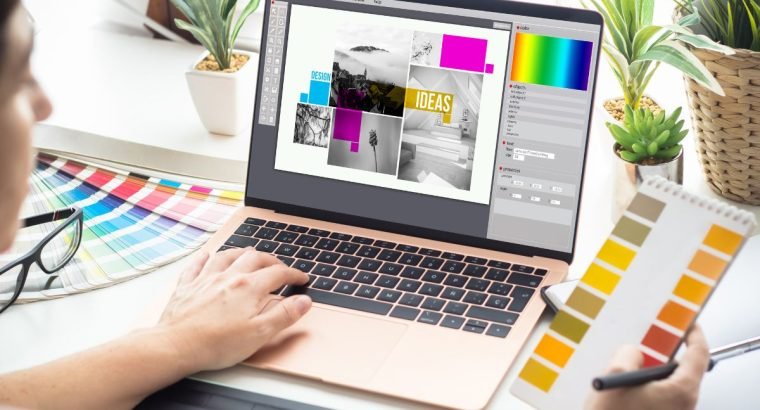How to Learn Graphic Design For Beginners
Mastering Graphic Design: A Comprehensive Guide
Graphic design is a versatile and in-demand skill that plays a crucial role in various industries, from marketing and advertising to web design and branding. Suppose you’re interested in diving into the world of graphic design or looking to enhance your existing skills. In that case, this comprehensive guide will serve as your roadmap to becoming a proficient graphic designer. We will cover fundamental concepts, tools, techniques, and tips to help you master graphic design.
Understanding Graphic Design
What is Graphic Design?
Graphic design combines visuals, typography, and imagery to communicate a message or idea effectively. It involves creating visually appealing and impactful designs across various media, such as print, digital, and multimedia.
Why Learn Graphic Design?
- Creativity: Graphic design is a canvas for your creativity. It allows you to bring your ideas to life and communicate them visually.
- Versatility: Graphic design skills are valuable in multiple industries, including marketing, advertising, web design, and publishing.
- Career Opportunities: The demand for skilled graphic designers is high, providing many job opportunities and freelancing prospects.
Getting Started with Graphic Design
Learn the Basics of DesignElements of Design:
- Line: Lines are used to create designs’ shapes, textures, and patterns.
- Shape: Shapes are fundamental in design and can be geometric or organic.
- Color: Understanding color theory is crucial. Learn about the color wheel, contrast, and color harmony.
- Typography: Fonts and typefaces play a significant role in design. Learn about font families, styles, and hierarchy.
Principles of Design:
- Balance: Achieving visual balance in your designs is essential for aesthetics and readability.
- Proportion: Proper sizing and scaling of elements contribute to a harmonious design.
- Contrast: Contrast helps elements stand out and grab the viewer’s attention.
- Alignment: Consistent alignment improves the overall look and feel of a design.
Get Familiar with Graphic Design Software
Mastering graphic design software is a crucial step. Popular software includes:
- Adobe Creative Cloud: Includes Photoshop for image editing, Illustrator for vector graphics, and InDesign for page layout.
- CorelDRAW: A vector graphic design software alternative to Illustrator.
- Affinity Designer: Known for its affordability and powerful features.
Explore Design Principles
Grids and Layouts:
- Grid Systems: Learn about grids for creating structured and organized layouts.
- Typography Layout: Understand how to arrange text for readability and visual appeal.
- Composition: Study the arrangement of elements within a design.
Practice and Experiment
Design is a hands-on skill. Practice regularly, create personal projects, and experiment with different styles and techniques to refine your skills.
Graphic Design Tools and Techniques
Image Editing
Photoshop Basics:
- Image Correction: Learn how to adjust photos’ brightness, contrast, and colors.
- Layers: Understand how layers work for non-destructive editing.
- Photo Manipulation: Explore techniques for merging and altering images.
Vector Graphics
Illustrator Essentials:
- Creating Vector Graphics: Learn to create logos, icons, and illustrations.
- Bezier Curves: Master the art of using the Pen Tool for precision.
- Typography: Combine text and graphics seamlessly.
- Layout and Print Design
InDesign Fundamentals:
- Document Setup: Create documents for print and digital media.
- Typography Layout: Design visually appealing pages with text and images.
- Master Pages: Utilize master pages for consistent layouts.
Web and UI Design
Web Design Tools:
- Adobe XD or Figma: Design websites and user interfaces with user experience in mind.
- Responsive Design: Learn how to design websites that adapt to various screen sizes.
Advanced Graphic Design
Animation and Motion Graphics
Explore animation software like Adobe After Effects to add motion to your designs and create eye-catching visuals.
3D Graphics
Learn 3D modeling software like Blender or Cinema 4D for three-dimensional designs and animations.
Specialization
Consider specializing in branding, logo design, or digital marketing design to refine your skills and build a niche portfolio.
Building a Career in Graphic Design
Portfolio Development
Create a strong portfolio showcasing your best work. Your portfolio is your ticket to job opportunities and clients.
Networking
Connect with other designers, join design communities, and attend industry events to expand your network.
Freelancing vs. Employment
Decide whether you want to work as a freelancer or seek employment in design agencies or corporations.
Conclusion
Graphic design is a dynamic and rewarding field that allows you to channel your creativity into visual storytelling. Whether designing for print, web, or multimedia, mastering graphic design requires dedication, practice, and continuous learning. By following the steps outlined in this guide, you’ll be well on your way to becoming a proficient graphic designer and unleashing your creative potential in visual communication. Start your graphic design journey today and let your imagination run wild.


